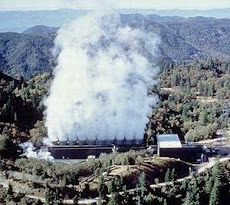Story in .rtf
Across the West, a handful of environmental groups are persuading Congress to bestow wilderness protection on their favorite stretch of country by trading away public land.
The Nature Conservatory

Taxpayers traded the Nature Conservancy 141 acres of commercial property in return for the right to continue using miles of road running through the 45 Ranch to reach the South Fork of the Owyhee River and thousands of acres of public land in Idaho. The $430,000 deal included purchasing the non-profit group's right to subdivide the ranch into vacation home sites. A proposal to create an Owyhee Canyonlands wilderness area in southwestern Idaho may offer similar deals to ranchers willing to trade access to wilderness areas for title to public land.
Such deals are the only way to protect the last unspoiled territory from development in the face of increasing political hostility, they say.
But controversial land swaps are causing a growing rift between environmentalists who are willing to deal and those who believe the price is too high. Not only are some groups trading away public land, they are relinquishing public water rights, inviting speculation in environmentally valuable acreage, fueling runaway growth in some of the most congested – and water-short – regions of the West and setting a precedent for future land giveaways, critics charge.
Objectionable or not, this deal making is likely to persist. Two of the most significant examples are unfolding in Idaho.
The Nature Conservancy is helping negotiate the proposed transfer of thousands of acres of U.S. Forest Service and Bureau of Land Management land – including a slice of the Sawtooth National Recreation Area – to Custer County, Idaho. If the proposal wins congressional approval, this central Idaho county plans to sell the land to private developers, ranching, timber and other interests.
In return, the county commissioners are expected to support wilderness designation for a portion of the Boulder and White Clouds mountains – an area at the heart of Idaho's wilderness debate for decades.
Two hundred miles to the southwest, the Conservancy, Idaho Conservation League, and other groups are forging a wilderness deal that some participants suggest should allow ranchers to trade federal grazing leases for public land or cash. Under this scenario, landowners adjacent to wilderness could receive public land or cash in return for providing access through their property.
Both proposals are expected to reach Congress this fall. Even if they fail, more are likely to follow.
Disposing of federally managed public land as a quid pro quo for congressionally designated wilderness was pioneered in Oregon and Nevada over the past three years. Now it's going to be the rule, predicts Lindsay Slater, chief of staff for U.S. Rep Mike Simpson, R-Idaho, who is pushing the Boulder White Clouds pact.
"We think stand-alone wilderness is done," Slater said. "The trend seems to be towards legislation based on compromise among the various interests."
After 20 years of frustration, "part of what we're trying to do is prove wilderness can still be done," added Rick Johnson, executive director of the Idaho Conservation League. This approach also could resolve wilderness conflicts elsewhere.
At what price? critics ask.
"Over time, this could become the established method of buying wilderness," said Steve Wolper, who lives near Idaho's Boulder White Cloud area. "It will be 10,000 acres this time, 50,000 acres the next, and 100,000 acres the next."
Consensus Business
Wilderness designation often precipitates some land exchanges to eliminate islands of private or state acreage, commonly called inholdings. In recent years, however, some environmental groups have succumbed to pressure to make large land trades part of their quest to win new wilderness areas.
The Nature Conservancy and environmental groups are negotiating to give Custer County, Idaho more than 10,000 acres of public land. In return, the County Commissioners are expected to support wilderness designation for parts of the Boulder and White Cloud mountain ranges in central Idaho.
One problem is "they don't care what the costs are," says Charles Hancock, retired chief Nevada appraiser for the BLM.
Take Steens Mountain in southeastern Oregon. Environmentalists agreed to trade 104,000 acres of public land and $5.1 million cash for 18,000 acres of private land on Steens Mountain. As a result, Congress created a 175,000-acre wilderness area in October 2000 and ranchers agreed to stop grazing livestock on more than half of the newly protected land. Another 1.2 million acres of public land was made off-limits to mineral and geothermal exploitation.
Custer Co.

If Custer County is given several thousand acres of public land as part of a Boulder White Clouds wilderness deal, part of the proceeds could go to buying conservation easements that give ranchers cash incentives to continue raising cattle instead of selling to developers or subdividing.
Politicians hailed it as a new model for wilderness. Lindsay Slater, who helped author the bill, moved from the staff of U.S. Rep. Greg Walden, R-Ore. to join Idaho Congressman Simpson's staff – and work on land trades in the Boulder White Clouds.
Meanwhile, an Oregon businessman acquired one of the key remaining private inholdings in the Steens wilderness and hinted he would develop it unless he could swap it for streamside national forest land near scenic Sisters, Ore.
Defenders of the swap said it was critical to the new wilderness. Critics characterized it as opportunistic real estate speculation – and stopped the trade before it went to Congress.
Meanwhile, rather than basking in the knowledge that they have secured a relatively pristine future for Steens, environmentalists are fighting to keep a 40-foot high dam from being built on an important redband trout creek, upstream from where it enters the wilderness. They also are trying to stop ranchers and landowners from driving in the wilderness at will – unintended byproducts of the compromise.
Dewatering Wilderness
A recent Nevada deal paved the way for a far more dangerous precedent, even in the eyes of some environmentalists who generally supported the effort.
The Clark County Conservation of Public Land and Natural Resources Act of 2002 created 452,000 acres of wilderness not far from Las Vegas. It gave thousands of acres of public property to area colleges and an airport project. The bill also ordered the BLM to sell 28,000 acres of public land, meaning private developers can add even more strip malls and thirsty subdivisions to the metropolitan area.
The legislation also makes history by stipulating the Nevada wilderness has no water rights. Idaho politicians cite the bipartisan support for that legislation as justification for stipulating the new Idaho wilderness areas not have water rights. The Idaho Conservation League says that's fine.

The home above was built on a conservation easement managed by the Nature Conservancy along the banks of central Idaho's famed Silver Creek. The structure was supposed to be a rental cabin for fishermen. The Nature Conservancy says it didn't discover the house was too large until an annual review of the easement, even though it has an office less than a mile away. Local residents worry that similar problems will develop if Custer County is given several thousand acres of public land. Custer County's plans include using proceeds from the sale of U.S. Forest Service and Bureau of Land Management land to purchase of additional conservation easements, which also could be managed by the Nature Conservancy.
Water experts find that alarming, especially considering the Boulder White Clouds are advertised as the headwaters of four major rivers.
"What is a wilderness area worth without a water right?" said Rachael Paschal Osborn, a prominent water law attorney in Washington state. "How do you protect wildlife, scenic and recreational values – which is what the Wilderness Act is about?"
This maneuver would allow people with existing water rights for grazing or mining to go after the water as well as open the door to new claims.
"In these water-short times in the West, that will inspire someone to figure out how to get at it," Osborn said. "When you talk about buying and selling property as part of (this wilderness) deal, the opportunity for corruption increases many fold."
Free Land
Giving away public property became part of a Boulder White Clouds wilderness deal because Custer County blames its economic woes on public ownership of 96 percent of its 3.2 million acres – split between the Sawtooth National Recreation Area, the Salmon-Challis National Forest and the BLM's Challis resource area. Livestock grazing and a bit of mining are the only remaining extractive industries. Wilderness designation will only make matters worse, county officials say, even though Custer Country borders the prosperous vistas of Sun Valley and the Sawtooth Wilderness Area.
"We're broke now," County Commissioner and land deal supporter Wayne Butts said. "We have no private land. We have a proposed playground for the rich and famous and the rest of us have to pay taxes."

The buildings in the left half of this aerial view (above) show the "fishing cabin" constructed on the Nature Conservancy's Silver Creek Preserve.
Congressman Simpson asked the Nature Conservancy to negotiate the specifics in part because of the group's land exchange expertise. The Conservancy hired two staff to help the county draft a wish list – including timberland and high-end home sites – a way to sell the land and a way to handle the profits. The group also may be in line to manage conservation easements funded by the land sales.
"These collaborative efforts, I think, are important to resolving issues like this," said Lou Lunte, an Conservancy official in Idaho. "I would see it nearsighted not to give them a chance."
Opponents say it is better to simply give the county and its 4,200 residents the money to buy ambulances, repair schools, revive the economy and help ranchers change habits that put them in conflict with environmental laws.
"I'm not really comfortable taking land that has some federal protection, turning it over to a county that has no zoning, no building codes and letting them sell it to anyone they want," said Steve Wolper, a resident of nearby Ketchum. "This is federal land that belongs to the American public…that could become a Disneyland theme park or a confined animal feed lot."
Cowboy Compromise
Trading public land for wilderness protection is on a different path in southwestern Idaho. For two years, environmentalists have been negotiating to get ranchers to support wilderness status for some of the deep volcanic canyons churning through these sage-steppe uplands and juniper forests.

Steve Wolper, (above) founder of Citizens for Smart Growth, opposes trading public land for the Custer County Commissioners' support for a Boulder White Clouds wilderness area. The county has no building and zoning codes, meaning it will have little control over what happens to the land once it's sold. Wolper also worries the deal will start a national trend of even larger public land giveaways.
A half-dozen drafts of the proposal called for ranchers to trade public land grazing leases for cash or title to other public land. Landowners adjacent to wilderness areas or recreation sites could have traded access across their land for public land or cash – via roads that, in some cases, were once routinely used by the public.
The Idaho Conservation League says it never supported such trades and declares that scheme dead. History and geography may unravel that resolve.
Access to large swaths of public land across the Owyhee region are blocked by small parcels of private land posted with no trespassing signs, according to the Bureau of Land Management.
That's one reason the Nature Conservancy, a partner at the Owyhee bargaining table, benefited from an earlier land swap here. The group received 141 acres of commercial land in Boise managed by the BLM in 2000. The $432,000 deal secured the public's right to continue driving through the Conservancy's ranch to reach both a popular rafting launch site on the South Fork of the Owyhee River and 130,000 acres of BLM-managed land.
Taxpayers purchased development rights to the 240-acre ranch in the same transaction – even though the Conservancy routinely advertises that it purchases properties like the 45 Ranch to prevent them from being turned into subdivisions. Yet, the fine print allows the Conservancy to run a small commercial guest lodge at the ranch, build an additional house, garages, maintenance shops and an airstrip if a nearby public runway becomes unusable.
Even if environmental negotiators have firmly rejected land exchanges as a part of an Owyhee wilderness pact, the nature of political deal-making means swaps can easily be added back into a bill at the last minute, warned Janine Blaeloch, director of the Western Land Exchange Project in Seattle.
"When consensus-seekers can feel that a deal is about to be struck," Blaeloch said, "the tradeoffs that once seemed completely distasteful become totally acceptable."
©2004 Ken Olsen
--------------------------------------------------------------------------------
Ken Olsen, a reporter for the Vancouver Columbian, is examining the hidden world of public land swaps during his fellowship year.



















No comments:
Post a Comment